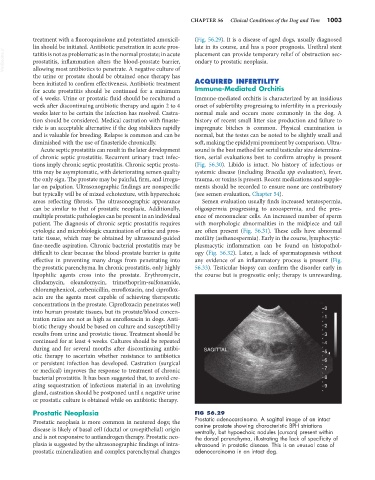Page 1031 - Small Animal Internal Medicine, 6th Edition
P. 1031
CHAPTER 56 Clinical Conditions of the Dog and Tom 1003
treatment with a fluoroquinolone and potentiated amoxicil- (Fig. 56.29). It is a disease of aged dogs, usually diagnosed
lin should be initiated. Antibiotic penetration in acute pros- late in its course, and has a poor prognosis. Urethral stent
VetBooks.ir tatitis is not as problematic as in the normal prostate; in acute placement can provide temporary relief of obstruction sec-
ondary to prostatic neoplasia.
prostatitis, inflammation alters the blood-prostate barrier,
allowing most antibiotics to penetrate. A negative culture of
the urine or prostate should be obtained once therapy has
been initiated to confirm effectiveness. Antibiotic treatment ACQUIRED INFERTILITY
for acute prostatitis should be continued for a minimum Immune-Mediated Orchitis
of 4 weeks. Urine or prostatic fluid should be recultured a Immune-mediated orchitis is characterized by an insidious
week after discontinuing antibiotic therapy and again 2 to 4 onset of subfertility progressing to infertility in a previously
weeks later to be certain the infection has resolved. Castra- normal male and occurs more commonly in the dog. A
tion should be considered. Medical castration with finaste- history of recent small litter size production and failure to
ride is an acceptable alternative if the dog stabilizes rapidly impregnate bitches is common. Physical examination is
and is valuable for breeding. Relapse is common and can be normal, but the testes can be noted to be slightly small and
diminished with the use of finasteride chronically. soft, making the epididymi prominent by comparison. Ultra-
Acute septic prostatitis can result in the later development sound is the best method for serial testicular size determina-
of chronic septic prostatitis. Recurrent urinary tract infec- tion, serial evaluations best to confirm atrophy is present
tions imply chronic septic prostatitis. Chronic septic prosta- (Fig. 56.30). Libido is intact. No history of infectious or
titis may be asymptomatic, with deteriorating semen quality systemic disease (including Brucella spp evaluation), fever,
the only sign. The prostate may be painful, firm, and irregu- trauma, or toxins is present. Recent medications and supple-
lar on palpation. Ultrasonographic findings are nonspecific ments should be recorded to ensure none are contributory
but typically will be of mixed echotexture, with hyperechoic (see semen evaluation, Chapter 54).
areas reflecting fibrosis. The ultrasonographic appearance Semen evaluation usually finds increased teratospermia,
can be similar to that of prostatic neoplasia. Additionally, oligospermia progressing to azoospermia, and the pres-
multiple prostatic pathologies can be present in an individual ence of mononuclear cells. An increased number of sperm
patient. The diagnosis of chronic septic prostatitis requires with morphologic abnormalities in the midpiece and tail
cytologic and microbiologic examination of urine and pros- are often present (Fig. 56.31). These cells have abnormal
tatic tissue, which may be obtained by ultrasound-guided motility (asthenospermia). Early in the course, lymphocytic-
fine-needle aspiration. Chronic bacterial prostatitis may be plasmacytic inflammation can be found on histopathol-
difficult to clear because the blood-prostate barrier is quite ogy (Fig. 56.32). Later, a lack of spermatogenesis without
effective in preventing many drugs from penetrating into any evidence of an inflammatory process is present (Fig.
the prostatic parenchyma. In chronic prostatitis, only highly 56.33). Testicular biopsy can confirm the disorder early in
lipophilic agents cross into the prostate. Erythromycin, the course but is prognostic only; therapy is unrewarding.
clindamycin, oleandomycin, trimethoprim-sulfonamide,
chloramphenicol, carbenicillin, enrofloxacin, and ciproflox-
acin are the agents most capable of achieving therapeutic
concentrations in the prostate. Ciprofloxacin penetrates well
into human prostate tissues, but its prostate/blood concen- 0
tration ratios are not as high as enrofloxacin in dogs. Anti- 1
biotic therapy should be based on culture and susceptibility 2
results from urine and prostatic tissue. Treatment should be 3
continued for at least 4 weeks. Cultures should be repeated 4
during and for several months after discontinuing antibi- SAGITTAL 5
otic therapy to ascertain whether resistance to antibiotics
or persistent infection has developed. Castration (surgical 6
or medical) improves the response to treatment of chronic 7
bacterial prostatitis. It has been suggested that, to avoid cre- 8
ating sequestration of infectious material in an involuting 9
gland, castration should be postponed until a negative urine
or prostatic culture is obtained while on antibiotic therapy.
Prostatic Neoplasia FIG 56.29
Prostatic neoplasia is more common in neutered dogs; the Prostatic adenocarcinoma. A sagittal image of an intact
canine prostate showing characteristic BPH striations
disease is likely of basal cell (ductal or uroepithelial) origin ventrally, but hypoechoic nodules (cursors) present within
and is not responsive to antiandrogen therapy. Prostatic neo- the dorsal parenchyma, illustrating the lack of specificity of
plasia is suggested by the ultrasonographic findings of intra- ultrasound in prostatic disease. This is an unusual case of
prostatic mineralization and complex parenchymal changes adenocarcinoma in an intact dog.

